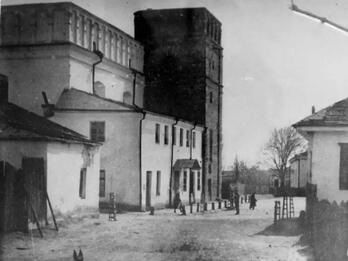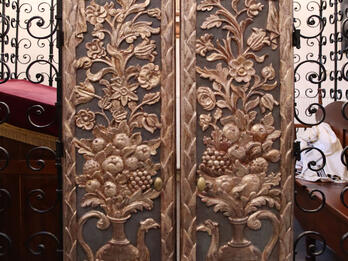Ḥavvot Yair (The Villages of Yair): On Ceremonial Objects
Yair Ḥayim Bacharach
1699
Question: A woman pledged, when she lay ill, to give her disukia, which is embroidered with gilt silver thread, to be made into a ceremonial object for the synagogue. The disukia is what is called in Polish partuch and in German Schurze [apron]. She asked me whether she should make from this [apron] a mantle for the Torah scroll or a cover for the…
Creator Bio
Yair Ḥayim Bacharach
Born in Moravia, Yair Ḥayim Bacharach was descended from Judah Loew, the Maharal of Prague. Bacharach’s grandfather and father both served as rabbi of Worms, and Yair Ḥayim himself was briefly rabbi of Koblenz. He was not chosen as the next rabbi of Worms, despite his father’s explicit request. Bacharach was one of the great halakhic authorities of his time. He wrote a major commentary on the Shulḥan ‘arukh called Mekor ḥayim (Source of Life), although he withdrew it when he learned that other commentaries had recently been printed. His most famous work is his collection of responsa, Ḥavvot Yair (The Villages of Yair; named in honor of his grandmother, Ḥava, who was renowned for her piety). After the city of Worms burned down, Bacharach spent the next ten years wandering, until, in 1699, two years before his death, he was asked, finally, to serve as rabbi of the reestablished community of Worms.
Related Guide
Early Modern Rabbis and Intellectuals on the Move
Carrying books and knowledge, itinerant rabbis and scholars traveled between communities, facilitating cultural exchange.
Related Guide
Early Modern Religious Practices
Early modern Jews both preserved tradition and innovated. Documents and legal texts reveal rich details about synagogue life, marriage, family relations, and death rituals.
You may also like
Shire Yehudah (The Songs of Judah)
Yosef omets (He Will Be Stronger): On Going to the Synagogue

Great Synagogue (Lutsk, Ukraine)
Responsum: On the Right to Bequeath a Mitzvah



